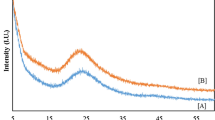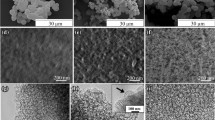Abstract
To improve the performance of covalently immobilized penicillin acylase (PA), the immobilization was carried out in mesocellular silica foams (MCFs) using p-benzoquinone as cross linker. The characterizations of the immobilized enzyme were studied carefully. The results showed that the relative activity of the immobilized PA was increased to 145% of that of free enzyme. The activity was 3.7 folds of that of PA on the silica nanoparticles. The enzyme in MCFs presented a turnover equal to that of free enzyme. It was also found that the optimum pH of the immobilized PA shifted to pH 7.5 and the optimum reaction temperature rose from 45 to 50 °C. Furthermore, the stability of PA was ameliorated greatly after immobilization. Fourier transform infrared spectroscopy showed no major secondary structural change for PA confined in MCFs. The proposed covalent immobilizing technique would rank among the potential strategies for efficient immobilization of PA.








Similar content being viewed by others
References
Kallenberg AI, Rantwijk FV, Sheldon RA (2005) Immobilization of Penicillin G Acylase: The Key to Optimum Performance. Adv Synth Catal 347:905–926
Sio CF, Quax WJ (2004) Improved β-lactam acylases and their use as industrial biocatalysts. Curr Opin Biotechnol 15:349–355
Gómez L, Ramírez HL, Neira-Carrillo A, Villalonga R (2006) Polyelectrolyte complex formation mediated immobilization of chitosan-invertase neoglycoconjugate on pectin-coated chitin. Bioprocess Biosyst Eng 28:387–395
Benkhelifa H, Bengoa C, Larre C, Guibal E, Popineau Y, Legrand J (2005) Casein hydrolysis by immobilized enzymes in a torus reactor. Process Biochem 40:461–467
Tümtürk H, Sahin F, Demirel G (2007) A new method for immobilization of acetylcholinesterase. Bioprocess Biosyst Eng 30:141–145
Katchalski-Katzir E, Kraemer DM (2000) Eupergit C, a carrier for immobilization of enzymes of industrial potential. J Mol Catal B: Enzym 10:157–176
Wang Q, Gao Q, Shi J (2004) Enhanced catalytic activity of hemoglobin in organic solvents by layered titanate immobilization. J Am Chem Soc 126:14346–14347
Maria Chong AS, Zhao XS (2004) Design of large-pore mesoporous materials for immobilization of penicillin G acylase biocatalyst. Catal Today 93–95:293–299
Basso A, De Martin L, Ebert C et al (2003) Organically modified xerogels as novel tailor-made supports for covalent immobilization of enzymes (penicillin G acylase). Tetrahedron Lett 44:5889–5891
Sheldon RA (2007) Enzyme immobilization: the quest for optimum performance. Adv Synth Catal 349:1289–1307
Zhou HX, Dill KA (2001) Stabilization of proteins in confined spaces. Biochemistry 40:11289–11293
Minton AP (2001) The influence of macromolecular crowding and macromolecular confinement on biochemical reactions in physiological media. J Biol Chem 276:10577–10580
Lei C, Shin Y, Magnuson JK, Fryxell G (2006) Characterization of functionalized nanoporous supports for protein confinement. Nanotechnology 17:5531–5538
Zong J, Chen YW, Shen SB (2006) Complex biocatalyst assembled by enzyme and inorganic/ metal nanoparticles. J Chem Ind Eng (China) 57:1777–1781
Xue P, Lu GZ, Liu WY (2006) Poly (GMA/MA/MBAA) copolymer beads: a highly efficient support immobilizing penicillin G acylase. Chin Chem Lett 17:129–132
Cheung MS, Thirumalai D (2006) Nanopore–protein interactions dramatically alter stability and yield of the native state in restricted spaces. J Mol Biol 357:632–643
Cheung MS, Klimov D, Thirumalai D (2005) Molecular crowding enhances native state stability and refolding rates of globular proteins. Proc Natl Acad Sci USA 102:4753–4758
Schmidt-Winkel P, Lukens WW, Zhao D et al (1999) Mesocellular siliceous foams with uniformly sized cells and windows. J Am Chem Soc 121:254–255
Tian B, Liu X, Yu C et al (2002) Microwave assisted template removal of siliceous porous materials. Chem Commun (Camb) 7:1186–1187
Stöber W, Fink A, Bohn E (1968) Controlled growth of monodisperse silica spheres in the micron size range. J Colloid Interface Sci 26:62–69
Bradford MMA (1976) Rapid and sensitive method for the quantification of microgram quantities of protein utilizing the principle of protein-dye binding. Anal Biochem 72:248–250
Shewale JG, Kumar KK, Ambekar GR (1987) Evaluation of determination of 6-aminopenicillanic acid by p-dimethylaminobenzaldehyde. Biotechnol Tech 1:69–72
Van Langen LM, Janssen MHA, Oosthoek NHP et al (2002) Active site titration as a tool for the evaluation of immobilization procedures of penicillin acylase. Biotech Bioeng 79:223–227
Pchelintsev NA, Youshko MI, Ŝvedas VK (2006) A new method for spectrophotometric assay of activity of cross-linked penicillin acylase aggregates. Biochemistry (Mosc) 71:315–319
Griebenow K, Klibanov AM (1995) Lyophilization-Induced Reversible Changes in the Secondary Structure of Proteins. Proc Natl Acad Sci USA 92:10969–10976
Van Roon JL, Schroën CGPH Tramper J, Beeftink HH (2007) Biocatalysts: measurement, modelling and design of heterogeneity. Biotechnol Adv 25:137–147
Atkins PW, De Paula J (2002) Atkins’ physical chemistry. 7th edn. Oxford University Press, NY
Chen B, Miller EM, Gross RA et al (2007) Effects of macroporous resin size on Candida antarctica lipase B adsorption, fraction of active molecules, and catalytic activity for polyester synthesis. Langmuir 23:1381–1387
Norouzian D, Javadpour S, Moazami N, Akbarzadeha A et al (2002) Immobilization of whole cell penicillin G acylase in open pore gelatin matrix. Enzyme Microb Technol 30:26–29
Kazan D, Ertan H, Erarslan A (1997) Stabilization of Escherichia coli penicillin G acylase against thermal inactivation by cross-linking with dextran dialdehyde polymers. Appl Microbiol Biotechnol 48:191–197
Duggleby HJ, Tolley SP, Hill CP, Dodson EJ, Dodson G, Moody PCE (1995) Penicillin acylase has a single amino-acid catalytic centre. Nature 373:264–265
Dong AC, Huang P, Caughey WS (1990) Proteins secondary structures in water from second-derivative amide-I infrared spectra. Biochemistry 29:3303–3308
Asuri P, Bale SS, Karajanagi SS et al (2006) The protein–nanomaterial interface. Curr Opin Biotechnol 17:562–568
Mcnay JL, Fernandez EJ (1999) How does a protein unfold on a reversed phase liquid chromatography surface. J Chromatogr A 849:135–148
Acknowledgments
This work was financially supported by the National High Technology Research and Development Program of China (863 Program, No.2006AA02Z211), National Natural Science Foundation of China (20376034), Natural Science Foundation of Jiangsu Province of China (BK2006181) and Foundation of Jiangsu Province of China for College Postgraduate Students in Innovation Engineering (2007). The research was performed at the National Engineering Research Center for Biotechnology sponsored by the Minister of Science and Technology of PR China.
Author information
Authors and Affiliations
Corresponding author
Rights and permissions
About this article
Cite this article
Wang, A., Wang, H., Zhu, S. et al. An efficient immobilizing technique of penicillin acylase with combining mesocellular silica foams support and p-benzoquinone cross linker. Bioprocess Biosyst Eng 31, 509–517 (2008). https://doi.org/10.1007/s00449-007-0189-x
Received:
Accepted:
Published:
Issue Date:
DOI: https://doi.org/10.1007/s00449-007-0189-x




